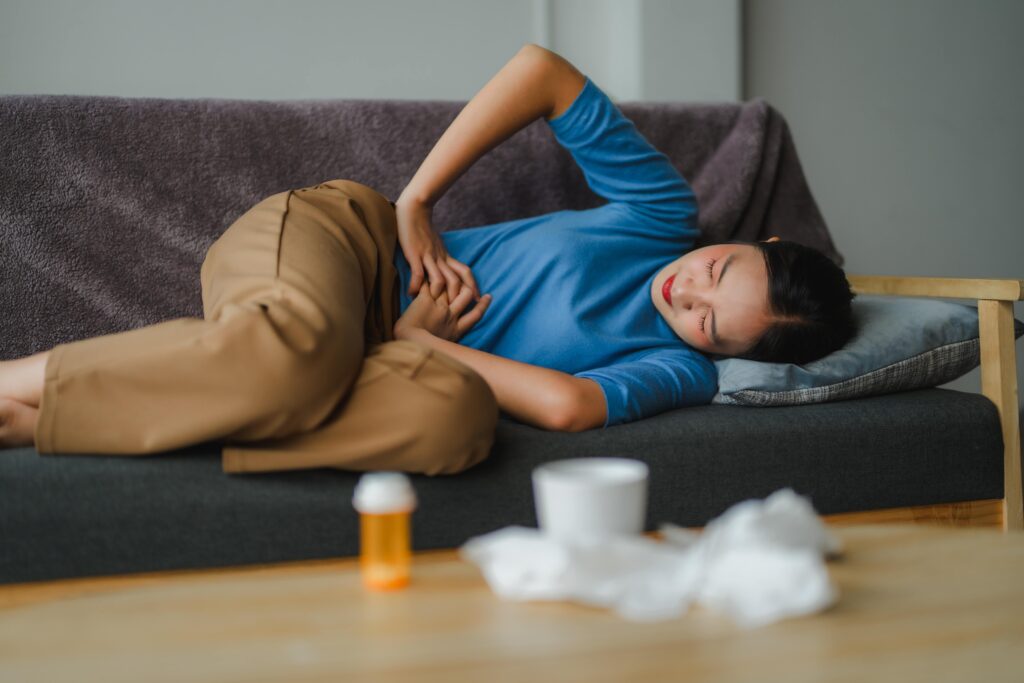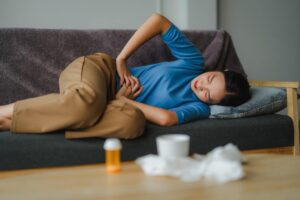How To Tell the Difference and When To See a Doctor
When nausea, cramps, and sudden trips to the bathroom strike, many people wonder: Is this food poisoning or just a stomach bug? The two share many symptoms, which can make it confusing to tell them apart.
However, understanding the difference matters because the causes, treatment, and when you should see a doctor aren’t always the same.
In this guide, we’ll break down the differences between food poisoning and stomach bugs, highlight the unique signs to watch for, and explain when it’s time to seek medical care.
You’ll also find prevention tips, treatment options, and answers to common questions about recovery and risks for children, older adults, and those with weaker immune systems.
Table of Contents
What Is Food Poisoning?
Food poisoning is an illness caused by eating food or drinking beverages contaminated with harmful bacteria, viruses, parasites, or toxins. The most common culprits include undercooked meats, unwashed produce, and food that’s been improperly handled or stored.
Common symptoms of food poisoning include:
- Vomiting
- Diarrhea
- Stomach cramps
- Fever (sometimes present)
Duration of symptoms: Food poisoning usually lasts from a few hours up to several days, depending on the type of contaminant and severity.
Causes of food poisoning often include:
- Consuming undercooked meat, seafood, or eggs
- Eating unwashed fruits and vegetables
- Cross-contamination during food preparation
- Improper refrigeration or food storage
- Bacteria such as Salmonella, E. coli, or Listeria
Because multiple people may eat the same contaminated meal, food poisoning often affects more than one person at the same time.
What Is a Stomach Bug? (Gastroenteritis)
A stomach bug, medically known as viral gastroenteritis, is most commonly caused by viruses such as norovirus or rotavirus. Unlike food poisoning, which comes from contaminated food, a stomach bug is usually spread from person to person or through contact with contaminated surfaces.
Common symptoms of a stomach bug include:
- Vomiting
- Diarrhea
- Stomach cramps
- Low-grade fever
Duration of symptoms: Most cases last 1–3 days, which is often shorter than food poisoning.
Causes of a stomach bug often include:
- Norovirus (the leading cause in adults)
- Rotavirus (more common in children)
- Close contact with an infected person
- Touching contaminated surfaces and then touching the mouth
- Consuming food or drinks handled by someone infected
Because it spreads so easily, stomach bugs are notorious for causing outbreaks in schools, daycare centers, and nursing homes.
Key Differences: Food Poisoning vs. Stomach Bug
Though they share many symptoms, food poisoning and stomach bugs differ in timing, source, and duration. Understanding these nuances can help you recognize what you’re dealing with.
Food Poisoning vs. Stomach Bug Symptoms
- Onset time:
- Food poisoning: Symptoms often appear within hours of eating contaminated food.
- Stomach bug: Symptoms usually develop 1–2 days after exposure to someone who is sick.
- Food poisoning: Symptoms often appear within hours of eating contaminated food.
- Symptom similarity: Vomiting, diarrhea, and stomach cramps occur in both. A fever is more common with a stomach bug, but certain bacterial foodborne illnesses can also trigger a fever.
Signs of Food Poisoning vs. Stomach Bug
- Link to food: Food poisoning is often tied to a recent meal and may affect several people who ate the same dish.
- Contagion: Stomach bugs spread mainly through direct contact with infected people or contaminated surfaces.
- Duration of illness: Food poisoning can last several days, while stomach bugs are usually shorter (1–3 days).
Special Considerations: Toddler Stomach Bug vs. Food Poisoning
When it comes to determining stomach bugs in toddlers vs food poisoning, it’s essential to understand the following considerations. Young children are more vulnerable to both conditions, and parents need to be especially cautious.
Common symptoms in toddlers include:
- Diarrhea and vomiting (present in both conditions)
- Fatigue and irritability
- High risk of dehydration
Signs of dehydration to watch for in toddlers:
- Dry mouth or lips
- No tears when crying
- Fewer wet diapers
Treatment and care for toddlers:
- Encourage frequent sips of water or an oral rehydration solution.
- Offer small amounts of bland foods if tolerated.
- Allow plenty of rest
When to see a doctor:
- If symptoms persist beyond 24–48 hours
- If your child shows signs of dehydration
- If vomiting is persistent or severe
Because toddlers can decline quickly, prompt care is essential. If you’re concerned, reach out to your pediatrician or schedule a visit with a HealthyU Primary Care provider.
How To Identify a 24-Hour Stomach Bug vs. Food Poisoning
24-Hour Stomach Bug
- Symptoms start suddenly, usually after contact with an infected person.
- Illness lasts only about a day.
- Often comes without a fever.
- Highly contagious in the first few hours.
Food Poisoning
- Symptoms can persist for more than 24 hours.
- Almost always associated with a particular meal or food source.
- Can affect several people who ate the same dish.
Differences in Recovery Time
- Stomach bug: Typically resolves in 24–48 hours.
- Food poisoning: Recovery may take several days, depending on the type of bacteria or contaminant.
When Should You See a Doctor?
Most cases of food poisoning or stomach bugs clear on their own, but some symptoms signal the need for medical attention.
Signs of Serious Illness
Seek medical help immediately if you notice:
- Persistent vomiting or diarrhea that doesn’t improve
- High fever (above 102°F / 38.9°C)
- Blood in stools or vomit
- Severe dehydration signs: dry mouth, dizziness, no urination for many hours
- Intense abdominal pain or cramps
Specific Populations at Higher Risk
Some groups are more vulnerable to complications and should see a doctor sooner:
- Young children, especially infants and toddlers.
- Older adults, who may dehydrate more quickly.
- Pregnant women due to potential risks for both mother and baby.
- People with weakened immune systems, such as those with chronic illnesses or undergoing cancer treatment.
How a Doctor Diagnoses Stomach Bug vs. Food Poisoning
Most cases of a stomach bug or food poisoning improve with supportive care at home. The goal is to keep your body hydrated and rested while symptoms run their course.
Rest
Give your body time to heal. Rest reduces strain and speeds recovery.
Hydration
- Drink clear liquids (water, broth, diluted juices).
- Oral rehydration solutions can replace electrolytes lost from vomiting or diarrhea.
Dietary Recommendations
- Start slowly with bland foods such as the BRAT diet (bananas, rice, applesauce, toast).
- Avoid fatty, spicy, or dairy-heavy foods until recovery is underway.
Over-the-Counter Medications
- Anti-diarrheal medications (like loperamide) or anti-nausea meds may help—but only when appropriate.
- Avoid use in young children unless directed by a healthcare provider.
When to Avoid Medication
Sometimes it’s better to let the illness run its course so the body can expel harmful bacteria or viruses. Always consult a healthcare professional before using medications.
If you’re unsure, consider booking an appointment with a HealthyU Provider for tailored medical advice and safe treatment options.
Prevention: How to Avoid Both Food Poisoning and Stomach Bugs
While you can’t always prevent illness, practicing careful hygiene and following safe food practices can significantly reduce your risk.
Food Poisoning Prevention
- Cook foods thoroughly — especially meats, seafood, and eggs.
- Refrigerate promptly to keep food out of the “danger zone” (40–140°F), where bacteria multiply quickly.
- Wash produce before eating.
- Avoid cross-contamination — use separate cutting boards for raw meat and fresh vegetables.
- Practice good hand hygiene when preparing or serving food.
Stomach Bug Prevention
- Wash your hands often, especially after using the restroom or before eating.
- Disinfect common surfaces like counters, doorknobs, and shared electronics.
- Avoid close contact with people who are sick.
- Stay home if you’re ill to reduce the spread of germs.
Vaccines for Stomach Bugs
The rotavirus vaccine is available for infants and is highly effective in preventing severe gastroenteritis.
Food Poisoning vs. Stomach Bug Recap
Food poisoning and stomach bugs may look alike at first glance, but their causes and timelines are different. Food poisoning typically results from contaminated food, while stomach bugs are often spread from person to person. Knowing the difference can help you treat symptoms more effectively and recognize when it’s time to see a doctor.
If you or your child experiences severe or prolonged symptoms, don’t wait. Schedule an appointment today with a HealthyU Primary Care provider. With locations in Arizona and California, our compassionate team is here to help you recover quickly.
Frequently Asked Questions
What is the fastest way to flush out food poisoning?
Hydration is key. Drinking water, broth, or oral rehydration solutions helps flush toxins and replace lost fluids.
What are the first signs of food poisoning?
Nausea, vomiting, stomach cramps, and diarrhea are often the first indicators, typically appearing within hours of eating contaminated food.
How do you rule out food poisoning?
Doctors may use stool tests or ask about recent meals. If multiple people become sick after consuming the same food, it’s more likely to be food poisoning.
How long does a stomach bug last compared to food poisoning?
Stomach bugs usually resolve within 24-48 hours, whereas food poisoning can persist for several days, depending on the cause.
What are the stages of the stomach bug?
- Sudden onset of nausea or cramps
- Vomiting and diarrhea
- Gradual recovery over 1–3 days
What is the quickest way to get rid of a stomach bug?
Rest, hydration, and bland foods are the best remedies. Most stomach bugs resolve on their own. For further guidance, connect with a HealthyU team member.








